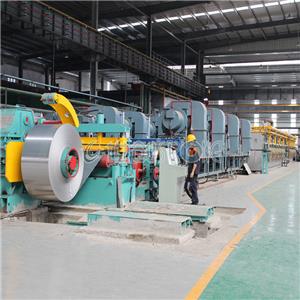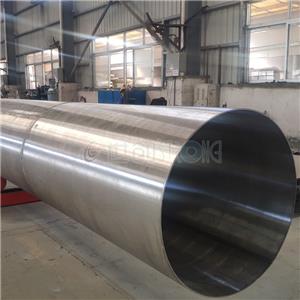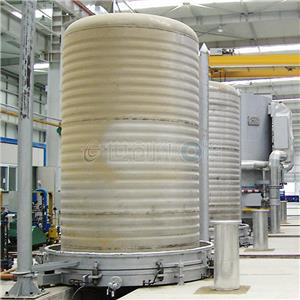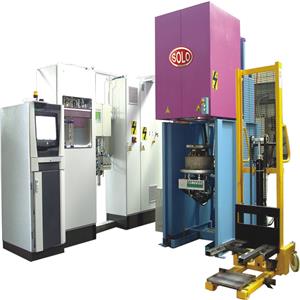Heat treatment of bearing steel - strong metal heat treatment furnace
Bearing steel ingots are generally subjected to long-term diffusion annealing at a high temperature of 1200 ~ 1250 ℃ to improve carbide segregation. The atmosphere in the furnace should be controlled during hot working, the heating temperature of the billet should not be too high, and the holding time should not be too long to avoid serious decarburization. The final rolling (forging) temperature is usually between 800 and 900 ℃. If it is too high, it is easy to appear coarse network carbides, and if it is too low, it is easy to form rolling (forging) cracks. The finished rolled (forged) material should be quickly cooled to 650°C to prevent cementite from precipitating in a network on the grain boundary. If conditions permit, a controlled rolling process can be used.
In order to obtain good machinability and pre-structure before quenching, the bearing steel for cold working should be fully spheroidized annealed. The annealing temperature is generally 780~800℃, and decarburization should be prevented during annealing. If there is too thick network cementite in the rolled steel, it needs to be normalized before annealing. Chromium bearing steel is usually heated at 830~860℃, oil quenched, and tempered at 150~180℃. In the structure of precision bearings, the amount of retained austenite should be reduced as much as possible or the retained austenite should be kept stable during use. Therefore, it is often necessary to perform cold treatment at -80°C (or lower temperature) and at 120~140 after quenching. Long-term stabilization treatment at ℃.
The heat treatment process of bearing steel includes two main links: pre-heat treatment and final heat treatment such as normalizing and annealing. GCr15 steel is a kind of high carbon chromium bearing steel with less alloy content, good performance and the most widely used. GCr15 bearing steel has high and uniform hardness, good wear resistance and high contact fatigue performance after heat treatment.
(1) Pre-heat treatment
①Normalizing: chromium bearing steel normalizing process, the workpiece is kept for 40~60min after diathermy, and the cooling needs to be faster. After normalizing, it will be converted to spheroidizing annealing immediately.
② Spheroidizing annealing: GCr15 chromium bearing steel often adopts isothermal spheroidizing annealing process, and 790℃ is considered as the best spheroidizing heating temperature. It needs to be heated to 900~920℃ before annealing and normalized after 2/3~1h.
The holding time depends on the size of the workpiece, the uniformity of the heating furnace, the method of loading the furnace and the amount of the furnace, and the uniformity of the original structure before annealing.
Low-temperature spheroidizing annealing is mainly used for recrystallization annealing of cold-punched balls and cold-extruded ferrules.
Ordinary spheroidizing annealing and isothermal spheroidizing annealing are mainly suitable for the annealing of forged ferrules, hot-punched balls and cross-forged balls. Spheroidizing annealing process of chromium bearing steel.
(2) Final heat treatment
①Bearing parts: Quenching and low temperature tempering are generally used, the purpose of which is to improve the strength, hardness, wear resistance and fatigue resistance of steel. The quenching temperature of GCr15 steel is 820~860℃, and the critical diameter of oil quenching is 25mm. Oil quenching is generally used. The heating and holding time is longer than that of alloy tool steel, and the salt bath heating coefficient is 0.8~1.5min/mm. The heating coefficient of the air furnace is 1.5~2min/mm.
For low temperature tempering at 160℃±10℃, the tempering time is generally 2~4h.
The precision bearing parts are of stable size. After quenching, they should be cold treated at -60~80℃, and the holding time should be 2~4h. After the cold treatment, the parts return to room temperature and temper within 4h to prevent the parts from cracking.
The residual stress that cannot be completely eliminated during low temperature tempering will be redistributed after grinding. These two stresses will cause the size of the part to change, and even cracks. For this reason, a supplementary tempering should be performed again, the tempering temperature is 120~160℃, and the heat preservation is 5~10h or longer.
②GCr15 heat treatment of tool and die: Because this steel is prone to white spot defects, large-scale tool and die heat treatment is prone to cracking, using slow heating or 690℃ for a long time (more than 5h) segmented isothermal can reduce the probability of cracking, and the austenitizing temperature is 810℃ ±10℃, heat preservation coefficient a=1.6~0.9min/mm. Workpieces larger than 60mm in diameter need to be quenched with water and oil.




